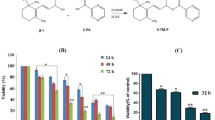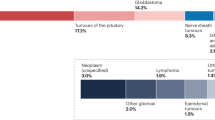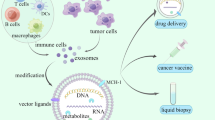Abstract
Estramustine, a combination of 17 beta-oestradiol and nor-nitrogen mustard, has been shown to be metabolised and to induce specific antiproliferative effects in malignant glioma, including arrest of glioma cells in the G2/M phase of the cell cycle, damage to cell membranes and DNA and induction of free oxygen radicals. To evaluate further the effects of estramustine, an in vivo rat glioma model using inbred BD-IX rats and the BT4C cell line was set up. In order to detect cells with fragmented DNA, tumour and brain specimens were, following fixation for histological examination, processed for in situ end labelling (ISEL) with biotin-labelled nucleotides. Fresh tissue fragments were also used for DNA integrity analysis on agarose gels. It was demonstrated that estramustine induced clusters of ISEL-positive cells and a pronounced typical fragmentation of DNA 0.5-8 h after treatment. In tumours examined 24 or 94 h after estramustine treatment, and in untreated tumours, only occasional single ISEL-positive cells were scattered in the tumour. DNA from normal brain tissue did not display any visible sign of fragmentation. These changes are indicative of programmed cell death induced by estramustine in glioma cells but not in normal brain tissue. Further studies are, however, needed to establish in detail the mechanism of cell death following treatment with the antimitotic drug estramustine.
This is a preview of subscription content, access via your institution
Access options
Subscribe to this journal
Receive 24 print issues and online access
$259.00 per year
only $10.79 per issue
Buy this article
- Purchase on SpringerLink
- Instant access to full article PDF
Prices may be subject to local taxes which are calculated during checkout
Similar content being viewed by others
Author information
Authors and Affiliations
Rights and permissions
About this article
Cite this article
Vallbo, C., Bergenheim, T., Bergh, A. et al. DNA fragmentation induced by the antimitotic drug estramustine in malignant rat glioma but not in normal brain - suggesting an apoptotic cell death. Br J Cancer 71, 717–720 (1995). https://doi.org/10.1038/bjc.1995.140
Issue date:
DOI: https://doi.org/10.1038/bjc.1995.140
This article is cited by
-
High-grade astrocytoma treated concomitantly with estramustine and radiotherapy
Journal of Neuro-Oncology (2006)
-
T-lymphocyte mediated tumor cell destructionin vivo associating with a specific feature of apoptosis
Chinese Journal of Cancer Research (1996)



